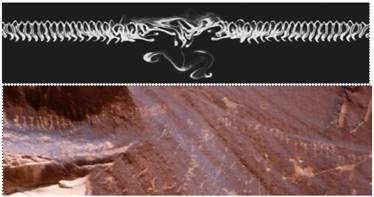
images from Bolivia:


Perhaps this phenomenon gave rise to the 'feathered serpent' Quetzelcoatl...

images from Bolivia:


Perhaps this phenomenon gave rise to the 'feathered serpent' Quetzelcoatl...
The recent THEMIS spacecraft discovery of two very large holes in the Earth's magnetosphere helps explain an anomaly in the global distribution of petroglyphs on our planet [1]. Previously, we reported a world wide GPS logging of some 4 million of these objects, each a picture of a filamental MHD instability carved in rock [2, 3]. In all cases, the field-of-view of the petroglyphs was true south with an off-horizon inclination between 21 -- 31 degrees. However, in a complete survey of the braided lava tube caves on Easter Island, petroglyphs were also found in long, true-north shafts, 50 m or more in length. This observation had been noted in natural shafts of similar lengths in the Columbia River Basin.From another PDF:
INTENSE SOLAR STORMS; CORROBORATION OF PREHISTORY ROCK RECORDINGS AND THEMIS MULTISPACECRAFT OBSERVATIONS
A. L. Peratt, Fellow IEEE
Los Alamos National Laboratory
Los Alamos, NM 87545 USA
W. F. Yao, Member, IEEE
Library and Technology Division, Albuquerque Public Schools, Albuquerque, NM 87122
The identification of prehistoric petroglyphs as artists recordings of MHD Z-pinch column instabilities has led to a global survey of these in 139 countries, from 70°N to 48°S.1, 2 In all cases, after a survey of fields of several million glyphs, the field-of-view (FOV) alignment is found to be within 1° of true south. This accuracy was determined from southviewing caves in the Arnold Lave Tube system in Oregon and California, caves along 300 km of the Orinoco River in Venezuela, 3 and the braided lava tube caves of Easter Island. Each unmoved petroglyph is treated as a pixel containing GPS position, survey transit FOV, and angle of inclination. GIS techniques on a 1-petaflop computer allow the reconstruction of a virtual image of the multi-gigaampere aurora. The reconstructed image shows one plasma column into the true South Pole at Antarctica. As the very intense solar storm appears sporadic, and its duration is very long compared to milder storms, it is not known if it was periodic, that is, if a north column once existed and evidence eroded due to time. Corroborating these results were witnesses of the polar storm of 1859 who reported ‘figures in the sky as if drawn with fire on a black background’.4 Unexpected were the 2008 observations of the THEMIS spacecraft whose discoveries were contrary to long standing views of how and when solar plasma enters the Earth’s magnetosphere. A northward IMF orientation was found to allow 20 times more solar wind plasma to penetrate the magnetosphere when the sun’s magnetic field is aligned with that of the Earth.5
1. A. L. Peratt, Characteristics for the occurrence of a highcurrent z-pinch aurora as recorded in antiquity. IEEE Trans. Plasma Sci. v.31, pp.1192-1214, 2003.
2. A. L. Peratt, J. McGovern, A. H. Qöyawayma, M.A. Van der Sluijs, and M. G. Peratt, Characteristics for the occurrence of a high-current z-pinch aurora as recorded in antiquity Part II: Directionality and source. IEEE Trans. Plasma Sci. v.35, pp.778-807, 2007.
3. A. L. Peratt and W. F. Yao, Evidence for an intense solar outburst in prehistory, Physica Scripta, T131, October 2008.
4. S. Clark, The Sun Kings: The Unexpected Tragedy of Richard Carrington and the Tale of How Modern Astronomy Began, Princeton University Press, 2007.
5. D. G. Sibeck, M. Øieroset, J. Raeder, and W. Li, Breach in the Earth’s magnetosphere discovered, 2008 THEMIS Science Nuggets.